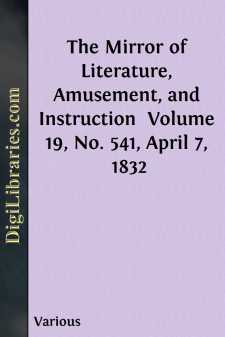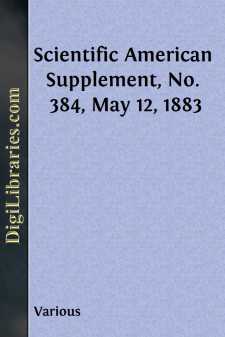Categories
- Antiques & Collectibles 13
- Architecture 36
- Art 48
- Bibles 22
- Biography & Autobiography 813
- Body, Mind & Spirit 142
- Business & Economics 28
- Children's Books 14
- Children's Fiction 11
- Computers 4
- Cooking 94
- Crafts & Hobbies 4
- Drama 346
- Education 46
- Family & Relationships 57
- Fiction 11828
- Games 19
- Gardening 17
- Health & Fitness 34
- History 1377
- House & Home 1
- Humor 147
- Juvenile Fiction 1873
- Juvenile Nonfiction 202
- Language Arts & Disciplines 88
- Law 16
- Literary Collections 686
- Literary Criticism 179
- Mathematics 13
- Medical 41
- Music 40
- Nature 179
- Non-Classifiable 1768
- Performing Arts 7
- Periodicals 1453
- Philosophy 64
- Photography 2
- Poetry 896
- Political Science 203
- Psychology 42
- Reference 154
- Religion 513
- Science 126
- Self-Help 84
- Social Science 81
- Sports & Recreation 34
- Study Aids 3
- Technology & Engineering 59
- Transportation 23
- Travel 463
- True Crime 29
The Mirror of Literature, Amusement, and Instruction Volume 19, No. 541, April 7, 1832
by: Various
Categories:
Description:
Excerpt
THE LOWTHER ARCADE.
In No. 514 of The Mirror we explained the situation of the Lowther Arcade. We may here observe that this covered way or arcade intersects the insulated triangle of buildings lately completed in the Strand, the principal façade of which is designated West Strand.
The Engraving represents the interior of the Arcade, similar in its use to the Burlington Arcade, and, although wider and more lofty, including three stories in height, it is not so long. The passage forms an acute angle with the Strand, running to the back of St. Martin's Church, and is divided by large pilasters into a succession of compartments; the pilasters are joined by an arch; and the compartments are domed over, and lighted in the centre by large domical lights, which illuminate the whole passage in a perfect manner. "All the shop-fronts are decorated in a similar manner, and the whole has been designed and executed with great care by the builder, Mr. Herbert. The shops on the exterior are designed to have the appearance of one great whole. The style of architecture is Grecian, and the order employed Corinthian: the angles are finished in a novel manner, with double circular buildings, having the roof domed in brick, with an ornament as a finish to the top of the dome. The effect of the whole would be agreeable if it had the appearance of a solid basement to stand upon; but as tradesmen find it necessary to have as much open space as possible to exhibit their goods, the mass of architecture above must appear to be supported by the window-frames of the shops, although in reality they are based upon small iron columns of four and six inches diameter, which are scarcely seen, and which offer the slightest possible impediment to the exhibition of goods."
We may add that the Arcade at night is lit with gas within elegant vase-shaped shades of ground glass, branching from each side. The ornaments of the domes, especially that of the Caduceus, are introduced with good effect.
We take the introduction of this and similar passages in the British metropolis to have been originally from the French capital. Thus, in Paris are the Passage des Panoramas; the Passage Delorme; the Passage d'Artois; the Passage Feydeau; the Passage de Caire; and the Passage Montesquieu. A more grandiloquent name applied by the French to some of their passages is galerie: we remember the Galerie Vivienne as one of the most splendid specimens, with its marchands of artificial luxuries. The Galerie Vero Dodat, (we think shorter than the Lowther Arcade,) is in the extreme of shop-front magnificence: the floor is of alternate squares of black and white marble, and the fronts are of plate-glass with highly-polished brass frames, and we doubt whether that common material, wood, is to be seen in the doors. This Galerie is named after its proprietor, M. Vero Dodat, an opulent charcutier, (a pork-butcher) in the neighbouring street; but we are unable to inform the reader by how many horse power his sausage-chopping machine is worked.
...











